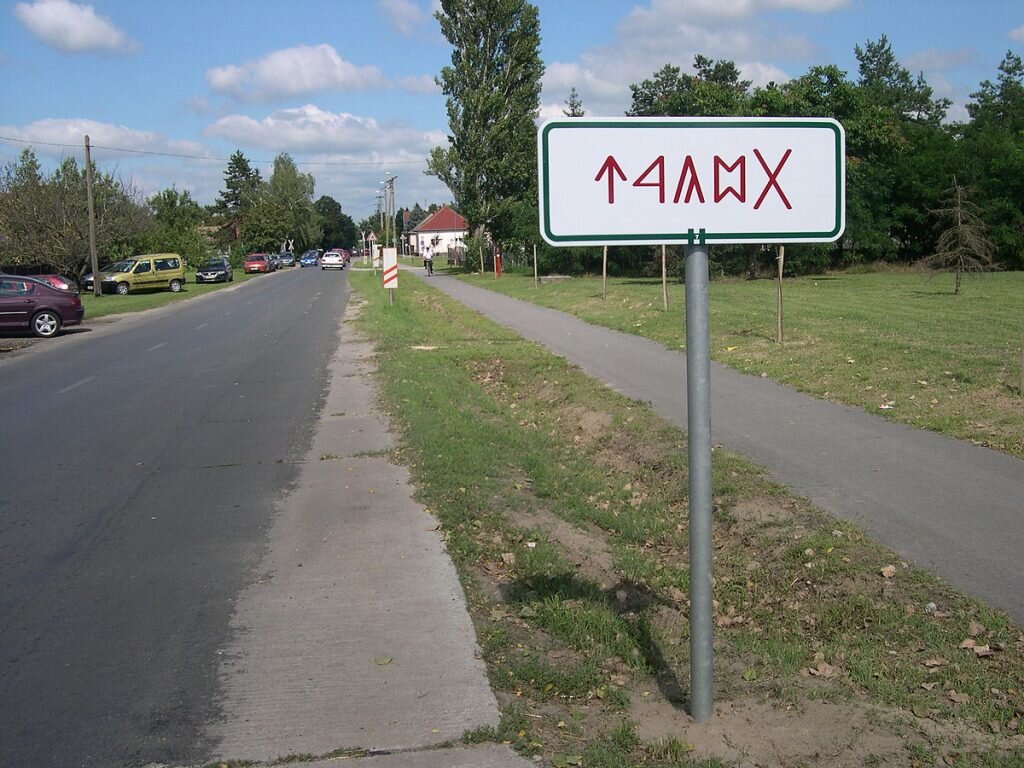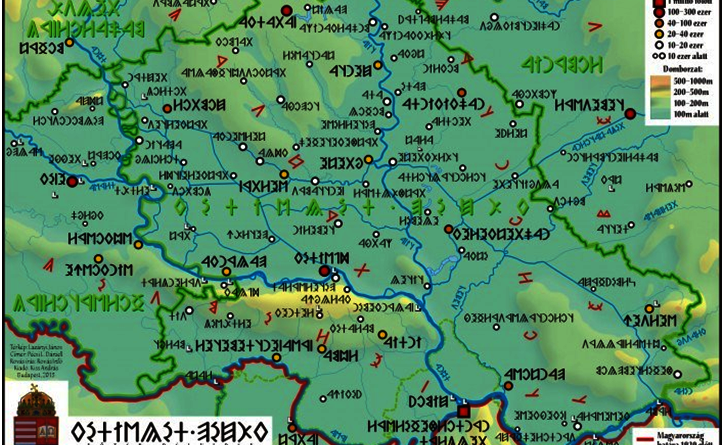New Illiberalism and the Old Hungarian Alphabet
Tomasz Kamusella
University of St Andrews
At the turn of the 21st century, I came across what then was dubbed in English as ‘Hungarian Runes.’ At this time I was researching the history of the use of various scripts and languages in central Europe. Until the 17th century, the Rovásírás (rovás ‘notch’ and írás ‘writing’) was employed in Transylvania in the form of brief inscriptions incised in wood. Memorably, the US historian of the Balkans, Peter Sugar, took notes in Rovás, when researching in Yugoslavia for his first monograph on Industrialization of Bosnia-Herzegovina, 1878-1918 (1963). This ploy allowed him to evade the unwanted scrutiny of Udba (Uprava državne bezbednosti), or the Yugoslav secret police. Sugar knew about this script because he had been born and raised in a Jewish family in Budapest. During World War II, Sugar was sent for safety to neutral Turkey, where he continued education in Istanbul. Obviously, Rovás is a Hungarian modification of the Old Turkish script (Orkhon alphabet), which emerged during the last third of the First Millennium among the Turkic peoples of central Asia. It was based on the Pahlavi script of the Iranian language and on the alphabet of the Iranic language of Sogdian, which used to be the lingua franca of traders traveling along the Silk Road. This Old Turkish script was re-discovered at the turn of the 20th century and became of much historical and ideological interest in early Republican Turkey, when a ‘purely Turkic’ form of Turkish national history and culture was rapidly invented. Of course, neither this Turkish writing system, nor Rovás has anything to do with the Germanic Runes (from Old German runa ‘secret, whisper’), devised in the Second century on the basis of the Latin alphabet in the Roman Empire’s borderlands in northern Europe. The superficial similarity of both Runes and Rovás is due to the method of their execution, that is, by incision on stone or wood.

However, the rapid political and ideological changes at the turn of the 21st century have successfully challenged central Europe’s present-day norm of triscripturality. In the course of the war of Yugoslav succession, Croatia reinvented itself as a historically and culturally unique nation-state, also on the level of the politics of script. First of all, Cyrillic was banned, deemed as ‘Serbian.’ This step facilitated the reemergence of Croatian as a language in its own right, following the split of Yugoslavia’s main official language of Serbo-Croatian. It used to sport two official scripts, namely, Cyrillic and Latin, whereas Croatian is written only in Latin letters. But a similar development took place among the Muslim Bosniaks, who also banned Cyrillic on the road to their own national tongue of Bosnian. Faced with this unwanted commonality, Croatian historians and philologists, often doubling as politicians, zoomed on Glagolitic. They made it into a potent symbol of Croatianness. Among others, this symbolic script allows for emphasizing the presumed Croatian uniqueness vis-à-vis the Bosniaks and their Latin alphabet-based Bosnian language.

Since 1993, Glagolitic summer schools have been regularly organized in Croatia for the patriotic sake of popularizing Glagolitic, including the skill of reading and writing in this script. In the traditional ecclesiastical use, Glagolitic was employed predominantly for printing and writing texts in Church Slavonic. Nowadays, this script is applied for writing in standard Croatian. Between 1996 and 2004, a standard Unicode set characters was developed for Glagolitic, so nowadays one can use this script on the internet, too. What is more, the (Church Slavonic) Wikipedia is written in both, Cyrillic and Glagolitic. In the mid-2010s, the Croatian state extended formal legal protection over Glagolitic with an eye to promoting its symbolic use, including support for elective lessons of how to read and write in Glagolitic in schools (https://www.stin.hr/multimedia/dokumenti/glagoljica-rjesenje.pdf). Glagolitic pops up across Croatia on monuments, in the form of Glagolitic letters or words on T-shirts, and even in biscriptural plaques with the names of local offices. But beyond this symbolic employment of Glagolitic, there is no wish among the population at large to use it as an officially acknowledged second alphabet of the Croatian language. No books or periodicals are published in Glagolitic, with the qualified exception of school textbooks on how to write and read Glagolitic. However, apart from Glagolitic examples, such manuals are mostly written in Latin letters.


To this day Glagolitic remains a potent symbol of Croatian nationalism and its reinvented traditionalism. The story of the recent rise of Rovás in Hungary is similar. However, some differences are telling. During the 1990s, in Hungary, an interest in Rovás was limited to scholars and amateur enthusiasts, some of whom were nationalists of conservative views. In 2003 the fringe World Association of Hungarians (Magyarok Világszövetsége) held a meeting in the Transylvanian town of Miercurea Ciuc (Csíkszereda), Romania, on the future of the Hungarian (Szekler) minority in the region. The delegates appealed for a territorial autonomy for Szeklers and their land, alongside Rovás-script road signs with the Hungarian names of Szekler towns and villages. Unsurprisingly, the Romanian authorities would not consider any of these requests, designed for questioning the legitimacy of Bucharest’s rule over Szeklerland.

In 1998, work began on developing a Unicode standard for Rovás. Fourteen years later, in 2012, such a standard was finally adopted for the officially named Old Hungarian (régi magyar) alphabet. Initially, two significant hurdles had to be scaled. First, the international community of Unicode users and developers long remained unconvinced that an internet standard of coding should be developed for an obscure script for writing Hungarian, though next to no one used it and the Hungarian government did not support this scriptural project. Second, Rovás is written from right to left, unlike the majority of European scripts (with the exception of the Hebrew writing system). Despite these difficulties, in the mid-2000s, enthusiasts began publishing entire books in Rovás. Basically, they are Hungarian-language texts transliterated into Rovás. The establishment of the Rovás Foundation (Rovás Alapítvány) in 2009 gave an immediate boost to these efforts, resulting in the first professionally published and marketed book in Rovás, tellingly, a collection of Hungarian folktales. This foundation maintains the vibrant online service Rovas Info, available, both, in Hungarian and English (http://rovas.info).

The game-changer was the 2010 rise to power of Viktor Orbán and his national-conservative Fidesz (Magyar Polgári Szövetség, Hungarian Civic Alliance) party, on the promise of ‘illiberal revolution’ that would end corruption and bring prosperity and stability to the average citizen. As a result, fringe nationalist groupings found themselves in the midst of the political center, which had dramatically shifted to the right. Prime Minister Orbán was quick to adopt these groupings’ main ideals and goals as his own, on the way to building a permanent parliamentary majority. Thus far, the majoritarian Fidesz government has remained unchallenged at the helm of power in Hungary for almost a decade. The Orbán administration also gave green light to a broader public use of the Hungarian national alphabet of Rovás. In 2010, with the aid of the Rovás Foundation’s expertise, official road signs with names of villages and towns in Rovás sprang up across Hungary (https://hu.wikipedia.org/wiki/Rovástáblás_települések_listája). The village of Bugac was the first one.

The Rovás Foundation, with governmental support, publishes books in Rovás, develops educational material, trains teachers who offer lessons of this Old Hungarian alphabet in schools, and organizes Rovás training courses. These courses are a helping hand to illiberal nationalists and Fidesz party activists. In the recent past, when some free press still remained in Hungary, liberally-minded democratic journalists enjoyed proving that such activists were opportunists, who, despite their vociferous support for Rovás, were unable either to read or write in this Hungarian national script. Apart from bookshops, the web, local and regional administrations, and schools, Rovás spreads in marketing and on apparel (https://dailynewshungary.com/rovas-the-szekely-hungarian-alphabet/). The authorities also allow for using Rovás in one’s personal signature.

Unlike in the case of Croatia’s Glagolitic, Hungary’s Rovás decidedly left the narrow confines of national symbolism, and nowadays functions as a genuine second alphabet of the Hungarian language. Many Hungarians read and write in Rovás, especially those who sympathize with the nationalist right. The national Hungarian alphabet evokes warm patriotic feelings in many, which the governing Fidesz party uses to attract voters, while companies deploy in advertising. In Croatia it is sufficient to be able to recognize Glagolitic letters by sight in order to be a good patriot, without the necessity of knowing which sound a given letter happens to denote. On the other hand, in Hungary a true patriot must be functionally literate in Rovás. The politics of script has been back in a big way in central Europe, while few seem to have noticed.

Rovás and the patriotic politics of script merge well with the subliminal irredentism of the Orbán administration, who take pride in adorning state offices with the map of pre-1918 ‘historic Hungary,’ ‘our Great Hungary,’ that is, before the Allies decided in Trianon that, on the ethnolinguistic basis, border parts of the old kingdom must be passed over to Austria, Czechoslovakia, Romania and the Kingdom of Serbs, Croats and Slovenes (Yugoslavia). No one protests that affording such an official recognition to this historic map may put Hungary at loggerheads with its neighbors, which are also members of NATO and the European Union. An illiberal conflict of the typical 20th-century ethnonational character is brewing. In 2015, the Rovás Foundation published Rovás maps of all the parts of historic Hungary, which remain outside the frontiers of today’s Hungarian nation-state (http://rovas.info/2015/11/delvidek-rovas-terkep/). Rovás-fueled Hungarian irredentism inches toward taking the center stage in Hungarian and central European politics.
July 2019
 Hungarian Prime Minister Viktor Orbán shows the map of historic Hungary to the Polish Prime Minister Mateusz Morawiecki, Budapest, April 2019 (Source: https://www.google.co.uk/url?sa=i&rct=j&q=&esrc=s&source=images&cd=&ved=2ahUKEwjVyrSwwJvjAhXMesAKHeu5Dy8QjRx6BAgBEAU&url=https%3A%2F%2Ftwitter.com%2Fkropka_hu%2Fstatus%2F982291015959793664&psig=AOvVaw3GlyU_UxyTrc_o7JRijMQM&ust=1562337896168888)
Hungarian Prime Minister Viktor Orbán shows the map of historic Hungary to the Polish Prime Minister Mateusz Morawiecki, Budapest, April 2019 (Source: https://www.google.co.uk/url?sa=i&rct=j&q=&esrc=s&source=images&cd=&ved=2ahUKEwjVyrSwwJvjAhXMesAKHeu5Dy8QjRx6BAgBEAU&url=https%3A%2F%2Ftwitter.com%2Fkropka_hu%2Fstatus%2F982291015959793664&psig=AOvVaw3GlyU_UxyTrc_o7JRijMQM&ust=1562337896168888)






